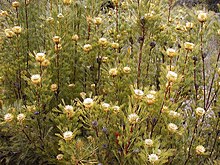en
names in breadcrumbs


Isopogon, commonly known as conesticks, conebushes or coneflowers,[3] is a genus of about forty species of flowering plants in the family Proteaceae, and are endemic to Australia. They are shrubs with rigid leaves, bisexual flowers in a dense spike or "cone" and the fruit is a small, hairy nut.
Plants in the genus Isopogon are erect or prostrate shrubs with rigid, usually compound, rarely simple leaves. Compound leaves are deeply divided with flat or cylindrical lobes. The flowers are usually arranged on the ends of branches, usually surrounded by bracts, in a more or less conical or spherical spike. Each flower is bisexual and symmetrical, the tepals spreading as the flower develops, the lower part persisting until the fruit expands. The fruit are fused to form a woody cone-like to more or less spherical structure, each fruit a nut with bracts that eventually fall and release the fruit. Isopogon have 13 haploid chromosomes.[3][4][5][6][7]
The genus Isopogon was first formally described in 1809 by Joseph Knight in On the cultivation of the plants belonging to the natural order of Proteeae, preempting publication of the same name by Robert Brown in his book On the natural order of plants called Proteaceae.[2][8]
The following is a list of species, subspecies and varieties of Isopogon accepted by the Australian Plant Census as at November 2020:[9]
Two new species of Isopogon, I. autumnalis (10 December 2019)[10][11] and I. nutans (5 May 2020)[12][13] have been described but the names have not been accepted by the Australian Plant Census as at November 2020.
 Isopogon anethifolius, Maranoa Gardens
Isopogon anethifolius, Maranoa Gardens Infructescence of Isopogon anemonifolius
Infructescence of Isopogon anemonifolius Isopogon, commonly known as conesticks, conebushes or coneflowers, is a genus of about forty species of flowering plants in the family Proteaceae, and are endemic to Australia. They are shrubs with rigid leaves, bisexual flowers in a dense spike or "cone" and the fruit is a small, hairy nut.